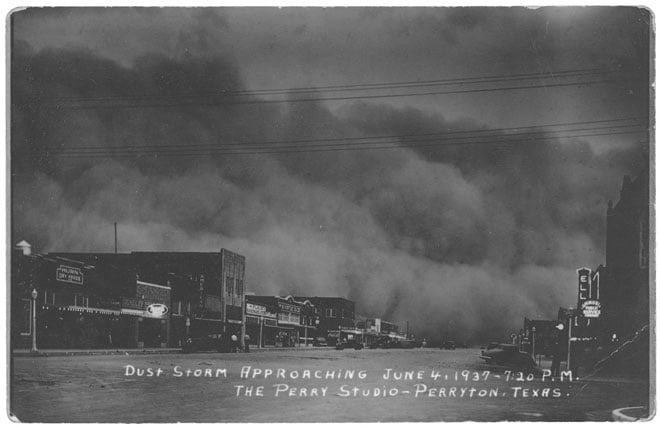The Weather Up There

The following photos and text are excerpted from Taming the Land: The Lost Postcard Photographs of the Texas High Plains, by John Miller Morris, published in April by Texas A&M University Press. The postcard photos reproduced here are from the author’s personal collection.

Albert Lawrence Wilson”It Snows in Texhoma”
Texas County. Severe winter weather is routine in the Panhandle, but the winter of 1911–12 was a small ice age. From November through April fierce blizzards tested the fortitude of isolated farmers and ranchers. Some snowfalls were so heavy that settlers were forced to dig tunnels out of their homes. Townfolk traveled along towering “snow bridges,” immense drifts that linked half-buried buildings together. Wags said the country was “open range” once more, as all the fences were buried. Most settlers, with prior experience or roots in the Great Plains communities farther north, coped admirably with the privations of being snowbound. But there were also reports of emergency situations—lack of food, fuel, doctors, or medicine—throughout the region.
Like many residents, A. L. Wilson took an abiding interest in the weather of the High Plains. He was fond of its precipitation events, photographing Texhoma in the aftermath of rains as well as winter blizzards. As this winter 1912 heavy snowfall suggests, the very top of Texas was far more Canada than Mexico. The worst of these winter storms smothered towns, threatened the lives of freighters, toppled windmills by the dozens, froze livestock, and generally buried the puny vertical improvements of mankind under a vast mantle of white horizontality.

Wyatt E. Perry”Dust Storm Approaching, June 4, 1937—7:20 p.m., The Perry Studio—Perryton, Texas”
Ochiltree County. While the April 14, 1935, dust storm was particularly memorable, other dusters periodically swept into town, as depicted in Wyatt Perry’s photo of the June 4, 1937, “black duster.” Merchants turned on their lights in an effort to dispel the approaching gloom. Although these storms were horrifying, most urban communities recovered fairly quickly with brooms and mops. These storms were devastating, however, to rural populations. Blowing sand killed off the tender shoots of planted crops, while massive soil erosion buried farm buildings in huge drifts.
A number of America’s most talented photographers were drawn to the 1930s dust bowl of the Texas Panhandle. Photographers from the Farm Service Administration (FSA)—including the exceptionally talented Dorothea Lange, Russell Lee, and Arthur Rothstein—arrived to document the searing human and environmental tragedy. Indeed, much of the 1930s FSA photography was the ultimate set of “disaster photos” for a region that lost five thousand farms and twenty thousand farmers.

George A. Addison”Rise in Canadian River, Sept. 8th ’09. Canadian … Texas”
Hemphill County. Four women watch an impressive “rise” on the Canadian River as a Santa Fe train steams across the railroad bridge leading into town. As the largest tributary of the Arkansas River, the Canadian River was notorious for its sudden rises. Heavy localized rains in the upper watershed—a realm stretching from the Sangre de Cristo Mountains of New Mexico through the Panhandle—could appear suddenly far downstream in Canadian as a mighty torrent on a sunny day. Although the four ladies appear untroubled, the railroad was perennially worried about rises. They sometimes swept away the bridge in a great “washout.” Addison’s dramatic photograph captures the fascination this environmental hazard exercises on the mind.
Postmark: “Newton & Amarillo R.P.O. TR4 Mar 5 1910” to Enid, Oklahoma.
Message: “Dear Friends. I will drop you a line as I promised. Got home all O.K. but it is very lonesome here. Have only heard from the little one once she got home. All O.K. I stop[p]ed at Shattuck and saw my Mother. Write soon —From W. C. Eaton.”

Charles M. and Luisa Flanders”Rainbow, Photo by Flanders, Friona, Tex.”
Parmer County. The celestial promise of rain, wealth, and good fortune appears to touch down in the new town of Friona. Rainbows, mirages, halos, and other optical events of the atmosphere were natural features of the High Plains. But sky phenomena were typically random and short-lived, and therefore difficult to photograph. This card is the only known real photo of a rainbow in the Panhandle. The photographer had to work quickly to capture the moment when sunlight was reflected and refracted off raindrops to form a rainbow with its foot anchored on the edge of town. Although sepia tinting washes out the six-color spectrum, the image was intended to be symbolic of the good fortune hovering over the new community. Rainbows were very appealing environmental images to farmers of the Great Plains.
Postmark: “Ama. & Ft. Worth R.P.O. TR 8 Oct 24 1909” from R. H. to Mrs. T. O. Wright, Roosevelt, Oklahoma.
Message: “We are in Amarillo on the train waiting for it to pull out for Friona. It is about 11:15 now. Saw Mary Cobb and her husband last night. She works in one of the stores here. Took quite a walk over town this morning. Lunch sure tasted fine. Will said to tell you that we sure put that chicken away and came very near eating the basket. Will write later. —R.H.”


